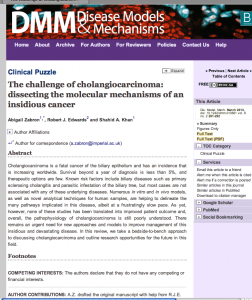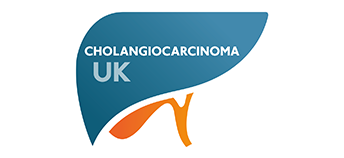Research Updates
CC: An Insidious Cancer
Dr Abigail Zabron, AMMF’s Research Fellow at Imperial College London, has produced a paper entitled, “The challenge of cholangiocarcinoma: dissecting the molecular mechanisms of an insidious cancer” which has just been published online in, “Disease Models and Mechanisms”.
The aim of this paper is to provide an overview of the various areas of basic CC research that has been covered in recent years, giving current molecular mechanistic knowledge, which has led to the pathways of cholangiocarcinogenesis beginning to be delineated – albeit frustratingly slowly. The various biomarkers that have been explored thus far are discussed and Dr Zabron notes that, whilst progress is being made, it is still not possible to provide an early and definitive diagnosis of CC, to predict which patients with high-risk conditions will go on to develop the disease, nor to provide effective targeted therapy for any patient group.
In summing up, Dr Zabron states that the insidious and complex nature of CC continues to be a challenge, and there remains an immense need for new approaches and models to improve management of this insidious and devastating disease, and for talented researchers to take on this task.
To read the paper in full, click here
The remit for this basic science review was to raise research interest for scientists, clinical but also non-clinical, in cholangiocarcinoma work, by producing an overview of current molecular mechanistic knowledge, discussing what model systems (patient samples, animals, cells etc) are available, and highlighting the main gaps in knowledge.
March 2013
Rising trends in cholangiocarcinoma: Is the ICD classification system misleading us?
The following is a “translation/summary” of an article recently published in the Journal of Hepatology that highlights the perceived problem in the classification of categories of cholangiocarcinoma.
(This technical translation of the published paper has been prepared for us by Dr Ruth Corrigan MA (Cantab), and a link to download the full paper can be found below the summary)It is essential to know whether the incidence of disease is increasing or decreasing for many reasons, including to determine both any associations with potential risk factors and the effect of any interventions, as well as to attract funding and research to areas of clinical importance and interest. To this end diseases are classified using an agreed set of criteria as set out in the World Health Organisation’s diagnostic manual, “International Classification of Diseases” or ICD.
With specific relevance to cholangiocarcinoma, ICD-Oncology or ICD-O is used. Editions are updated (eg ICD-0-2, ICD-O-3) in keeping with changes in the understanding of various disease processes and treatments. With reference to cholangiocarcinoma, diagnoses fall into two main categories, intrahepatic (affecting bile ducts within the liver) and extrahepatic (affecting bile ducts outside the liver). Of note, for a particular type of cholangiocarcinoma (Klatskin tumours), this categorisation has changed in each updated version of ICD-O. Klatskin tumours account for approximately 10% of all cholangiocarcinoma diagnoses. They are hilar tumours, occurring at junction of the left and right hepatic bile ducts and are therefore anatomically extrahepatic. However the second edition of ICD-O (introduced to the UK in 1995) reclassified Klatskin tumours as intrahepatic. Furthermore in 2001 when the third ICD-O was adopted in the UK, Klatskin tumours could be designated either intrahepatic or extrahepatic.
Of further interest, it has been reported that over the same time period the incidence of intrahepatic cholangiocarcinoma has increased, whereas that of extrahepatic cholangiocarcinoma has decreased.
In this paper Khan et al question whether changing the subtype classification of Klatskin tumours has contributed to the apparent change in rate of incidence of intrahepatic and extrahepatic disease. Khan et al found that the incidence of intrahepatic cancers in England and Wales rose between 1990 to 2008, whereas the incidence of extrahepatic cancer fell over the same period. Subsequently they reclassified Klatskin tumours identified after 1995 and the introduction of ICD-O-2 as intrahepatic and found that though this had no effect on the overall trends, small changes in the exact figures were noted. This is because Klatskin tumours accounted for only 1% of the total cholangiocarcinoma cases reported in England and Wales.
Analysis of data from the USA found that the incidence of intrahepatic rose until 2001 before sharply dropping, reaching a new plateau in 2007. Conversely, the incidence of extrahepatic disease remained stable until 2001 then increased until 2007. Of note this change in the pattern of incidence coincides with switch to ICD-O-3 in 2001. This study raises several interesting points. Firstly, changing how diseases are classified affects their apparent incidence and can give a false impression of how rates are changing.
Furthermore such re-classification is complicated by different countries introducing new definitions at different times. More specific to cholangiocarcinoma, this study also found that though the same disease entity, Klatskin and hilar tumours can be coded separately, thus giving a false impression if either number is studied in isolation (and accounting for the very low reported rate of Klatskin tumours in England and Wales).
The authors recommend that clinicians seek clarification of the tumour location and record this precisely, as well as reclassification of Klatskin and hilar tumours as the same entity, or reclassification of cholangiocarcinoma subtypes entirely, based on anatomy, for example intrahepatic, perihilar or distal. Disease classification after all is only useful if classification is accurate, consistent and biologically relevant.
Finally the authors emphasise that despite this anomaly in classification, the incidence of cholangiocarcinoma overall is increasing and elucidating the reasons why remains a research priority.
To view the full, published article, click here
27.06.12
Risk Factors for Cholangiocarcinoma
The following is a brief summary of Tyson and El-Serag’s paper reviewing scientific literature up to and including March 2011, entitled “Risk Factors for Cholangiocarcinoma”, which was recently published in the journal Hepatology.
(The following technical translation of the published paper has been prepared for us by Dr Ruth Corrigan MA (Cantab), and a link to download the full paper can be found below the summary)Cholangiocarcinoma (CC) is the second most common primary hepatic malignancy after hepatocellular cancer. People below the age of 40 are rarely affected, and most people are diagnosed in their 60s. Worldwide, CC accounts for approximately 10%-25% of all hepatobiliary worldwide, although there are considerable geographic variations in the incidence of CC, largely attributed to geographical variations in known CC risk factors (particularly parasitic infections, see below). However it is important to note that for the majority of CC cases in the Western world no risk factors are evident, and thus these cases are classified as “sporadic” cholangiocarcinoma. Much research is still required in order to find out more about why CC develops. This paper aims to summarise what is known about CC risk factors to date. In this paper the authors review 63 scientific articles relating to risk factors for the development of CC. In general, risk factors for diseases are identified using one of two methods: either by comparing people with and without the disease of interest and looking for any differences between the groups which may be linked to the development of the disease in question, or by looking at people with and without proposed risk factors and comparing how many from each group develop the disease of interest. This paper looks at the conclusions of many of these studies to provide an overview of our current knowledge of risk factors for CC. Initially this paper reviews the evidence for known CC risk factors, for example parasitic infection of the biliary tree (prevalent in South East Asia) and the autoimmune disease primary sclerosing cholangitis. Next the paper highlights possible CC risk factors such as inflammatory bowel disease, diabetes and obesity and summarises the evidence for each. It is important to note that although risk factors can be identified at a population level, that is to say “people with primary sclerosing cholangitis are more likely to develop CC than those without”, it remains almost impossible to identify individual risk factors in patients diagnosed with CC, that is to say “this patient developed CC because..”.
Known Risk Factors For CC
The following risk factors are all accepted by scientists to increase the likelihood of developing CC:
Parasitic infections
Biliary tree disorders including bile duct cysts
Primary sclerosing cholangitis
Bile duct stones
Toxins
Conditions are considered risk factors for a disease if numerous studies by different groups of scientists have come to this conclusion. Some examples of such work in relation to CC are described below.
Firstly, studies from Thailand have found that people with CC were between 5 and 27 times as likely to have antibodies indicating infection with the parasite Opisthorchis viverrini than similar people without CC.
Similarly, patients with bile duct cysts (arising due to a developmental abnormality of their bile duct anatomy) are reported as having a 50 fold increased risk of developing CC compared to those with normal bile duct anatomy.
Equally a study of Chinese patients found that those with gallstones high up in the billiary tree (before the left and right hepatic ducts join) were also 50 times more likely to get CC compared to those without.
Furthermore a Japanese study found that people exposed to the radiographic contrast agent Thorotrast were 300 times more likely to get CC than those who were not exposed, strongly implicating this toxin in the development of CC.
However, it is important to note that although such conditions are consistently linked to a high risk of CC, the percentage of CC cases which can be attributed to each of these known factors is unknown, and likely to be low. For example, it has been estimated that only 10% of CC can be attributed to primary sclerosing cholangitis, even though up to one in three of these patients will develop CC.In practical terms this means that many risk factors are yet to be identified.
Possible Risk Factors For CC
The involvement of some factors in the development of CC is currently unclear, as the conclusions from studies are either conflicting or there are too few studies to be certain. Such factors include:
Inflammatory bowel disease
Choledocholithiasis and cholangitis
Hepatitis B or C and cirrhosis
Diabetes and obesity
Alcohol use
Smoking
Genetic factors
Before discussing these potential risk factors the authors of this review suggest that CC ought to be considered as two entities; intrahepatic and extrahepatic CC, based on whether the cancer affects bile ducts inside, or outside of the liver. This is because they suggest that some less well established risk factors can be more strongly associated with a particular subtype of CC.
With regard to the proposed risk factors listed above, current research as included in the review is summarised below.
Inflammatory bowel disease (IBD). Several studies have investigated the link between IBD and either or both intra- and extrahepatic CC, with mixed results. Conclusions are further complicated by the fact that primary sclerosing cholangitis is itself more likely in people with IBD and it remains unclear whether any link between IBD and CC is in fact due to the increased risk of primary sclerosing cholangitis in IBD patients.
Choledocholithiasis and Cholangitis. In a similar vein, although both the presence of gall stones in the common bile duct (choledocholithiasis) and infection of the common bile duct (cholangitis) have also been associated with increased risk of CC in at least 3 studies it is unclear how much this is due to an increased risk of primary sclerosing cholangitis in these patients.
Hepatitis B or C and Cirrhosis. The link between hepatitis B or C with CC is equally unclear. Conflicting studies from Asia find that hepatitis B (but not C) is associated with CC, also that hepatitis C (but not B) is associated with CC, and that infection with either virus is not associated with CC. However, in European studies both hepatitis C infection and liver cirrhosis have been linked to an increased risk of developing CC, but hepatis B has not. Finally, three studies from the United States find that hepatitis C infection is associated with an increased risk of intrahepatic CC, whereas no studies have implicated hepatitis B in the development of either subtype.
Diabetes and Obesity. With regard to diabetes, the field is split, with four studies (including two large American studies) finding a potential link between diabetes and CC, but at least four finding no significant association. Again, there are studies suggesting both that obesity is and is not linked to the development of CC, but the evidence to date is too sparse to be suggestive one way or the other.
Alcohol Use. The role of alcohol use in the development of cholangiocarcinoma is similarly disputed by several studies. However, since some studies reviewed find a significantly increased CC risk of 2-15 fold in those who drink heavily compared to those who do not, the authors of this review consider it likely that heavy alcohol use is associated with an increased risk of CC.
Smoking. Interestingly, at best, smoking is only a weak risk factor for CC, but again, conflicting data from a variety of studies, some of which failed to quantify the amount of tobacco smoked mean that no firm conclusions can be made.
Genetic Factors. Finally, numerous studies have implicated many different genes involving enzymes responsible for the disposal of waste products, DNA and the immune response in the development of CC, however more work is needed to draw out consistent findings from such studies.
Summary:
In summary, with the exception of CC in countries where liver flukes are common, most cases of CC are not associated with one of the established risk factors for the disease. This is especially true in the Western world where the majority of cases of cholangiocarcinoma are classified as “sporadic”, that is to say that the causal factor is unknown. This suggests that other risk factors must exist and raises the possibility that some of these could be associated with particular disease cases. To date, data regarding the role of IBD, obesity, smoking and genetic variations is not strong enough to prove or disprove an association with CC. However, current evidence is suggestive that diabetes, heavy alcohol intake and HCV (in Western countries) may be associated with increased risk of developing CC. Given that CC in different parts of the biliary tree may have different risk factors the authors of this review also emphasize the need for a clear and consistent method of classifying cancers of the liver and biliary tree system.
Click link to read the full article: El Serag CC risk factors review
Genetic Risk Factor Study / Imperial College
A recent study at Imperial College has investigated whether or not specific genes involved in tumour immunity are associated with the development of sporadic cholangiocarcinoma. The results suggest that a wider study assessing the differences in many genes between people with and without cholangiocarcinoma may reveal genetic risk factors for the development of this cancer.
and for a “translation” of the work, prepared for us by Dr Ruth Corrigan, click here
Cholangiocarcinoma:
Guidelines for Treatment and Diagnosis (UK)








